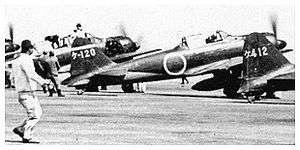Genzan Air Group
The Genzan Air Group (元山海軍航空隊, Genzan Kaigun Kōkūtai) was an aircraft and airbase garrison unit of the Imperial Japanese Navy Air Service during the Second Sino-Japanese War and Pacific campaign of World War II.
| Genzan Air Group | |
|---|---|
 Genzan A6M2b fighters at Genzan (Wonsan), Korea in April 1945. | |
| Active | 15 Nov 1940 – 1 Nov 1942 15 Aug 1944 – the end of war |
| Country | Empire of Japan |
| Allegiance | Imperial Japanese Navy |
| Branch | Imperial Japanese Navy Air Service |
| Type | Naval aviation unit |
| Role | Bomber and fighter support (1940) Training (1944) |
| Garrison/HQ | Wonsan, Korea Hankou, China Saigon, French Indochina Rabaul, New Britain Kanoya, Japan |
| Engagements |
|
| Insignia | |
| Identification symbol | ゲン (Gen, 1940, Japan homeland) |
| Identification symbol | G (1940, outside Japan homeland) |
| Identification symbol | ケ (Ke, 1944) |
| Identification symbol | ゲン (Gen, August 1945) |
History
The Genzan Air Group was founded on 15 November 1940 at Genzan, Korea, then a part of the Empire of Japan. It was initially a mixed-unit equipped with 33 Type 96 Mitsubishi G3M1 bombers and 25 Type 96 Mitsubishi A5M4 fighters under the command of the Second Air Fleet. On January 15, 1941, it was reassigned to the 22nd Kōkū Sentai and deployed to Hankou in central China.
Operations in China
While based at Hankou, the bombers of the Genzan Air Group was primarily assigned to strategic bombing missions in Sichuan Province, while the fighters were assigned to combat air patrol and ground support missions in support of Imperial Japanese Army operations. The Genzan Air Group was withdrawn from China in September, 1941, returning to its home base at Genzan for training, and at the end of October, 1941 was forward deployed to Takao in Taiwan.
Operations in Southeast Asia
With the bombing of Pearl Harbor and the outbreak of the Pacific War, the Genzan Air Group was deployed to Saigon, French Indochina. The group was a key participant in the sinking of the British capital ships HMS Prince of Wales (53) and HMS Repulse (1916) off the coast of Malaya on 10 December 1941, losing one aircraft and its crew during the battle.
On January 22, 1942, bombers from the Genzan Air Group attacked Kallang Airport in Singapore, and subsequently provided air support for Japanese offensives in Malaya including the landings at Endau. At the end of February, the unit was transferred to Bangkok and assigned to patrols over the Indian Ocean; however, facilities at Bangkok were not satisfactory and the unit was soon reassigned to Palembang in Sumatra in the Netherlands East Indies, with some aircraft dispersed to Kuching in Sarawak.
On May 1, 1942, Genzan's flying unit was redeployed to Rabaul, New Britain to support the Japanese campaign in New Guinea. The group participated in the Battle of the Coral Sea, without success, and made numerous bombing attacks against Port Moresby.
In July, after the cancellation of Operation Mo, the unit was withdrawn to Japan and was based at Misawa, Aomori for training. Its fighter unit was detached and redesignated as the 252 Kōkūtai in September. The Genzan's flying unit was disbanded by being redesignated as the 755 Kōkūtai on 1 November 1942.
References
- Bullard, Steven (translator). Army Operations in the South Pacific Area, New Britain and Papua campaigns, 1942–43 Senshi Sōshō (translated excerpts). Canberra: Australian War Memorial, 2007. ISBN 978-0-9751904-8-7.
- Cea, Edwardo (2008). Aircraft of the Imperial Japanese Navy. Valaldolid, Spain: AF Editions. ISBN 978-84-96935-12-9.
- Hata, Ikuhiko with Yasuho Izawa and Don Cyril Gorham (translator). Japanese Naval Aces and Fighter Units in World War II. Annapolis, MD: Naval Institute Press, 1975 (Japanese original) 1989 (translation). ISBN 0-87021-315-6.
- Peattie, Mark R. Sunburst: The Rise of Japanese Naval Air Power, 1909-1941. Annapolis, MD: Naval Institute Press, 1999. ISBN 1-59114-664-X.
- Tagaya, Osamu. Mitsubishi Type 1 "Rikko" 'Betty' Units of World War 2. Botley, Oxfordshire, UK: Osprey Publishing, 2001. ISBN 1-84176-082-X.
- Monthly Kōkū-Fan, Illustrated No. 42, Japanese Imperial Army & Navy Aircraft Color, Marking, Tōkyō, Japan, Bunrindō Co. Ltd., 1988.
- Monthly Air World, Photo album of Imperial Japanese Navy Aircraft, Tōkyō, Japan, Air World Inc., 1987.
- Model Art No. 458, Special issue Imperial Japanese Navy Air Force Suicide Attack Unit "Kamikaze", Tōkyō, Japan, Model Art Co. Ltd., 1995.